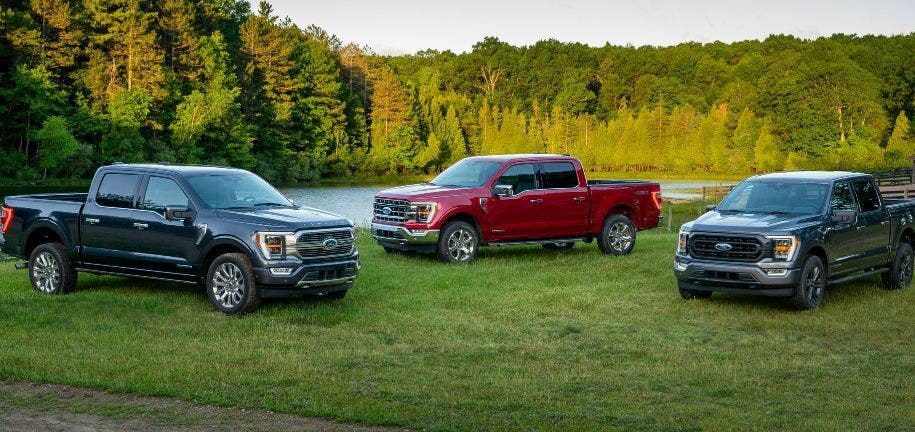The Ford F-150, a stalwart in the full-size truck segment, boasts a long-standing reputation for power, capability, and American muscle. However, navigating the vast array of trim levels, model years, and potential issues can be daunting for potential buyers. This comprehensive guide delves into the key factors to consider when purchasing an F-150, empowering you to find the perfect truck for your needs and budget.
Ford F-150 Prices:
The F-150's price range is vast, spanning from budget-friendly options to luxury leviathans. Here's a breakdown to help you estimate:
-
Model Year:
-
- 2024: Expect brand-new F-150s to start around $36,570 for the basic XL Work Truck and climb to $77,980+ for high-end Limited trims with loaded configurations.
- 2019-2023: Used models within this range offer a balance of features and affordability. Expect $25,000-$55,000 depending on trim, mileage, and condition.
- 2015-2018: Older models can be found for $15,000-$35,000, but be mindful of potential reliability concerns.
- Pre-2015: While attractive on price (under $15,000), these earlier models might have higher maintenance costs and reliability risks.
-
Trim Level:
-
- XL Work Truck: The base trim offers essential features, starting around $36,570 new.
- XLT: Adds comfort features like air conditioning and cruise control, costing $47,620 new.
- Lariat: Enhances comfort and convenience with heated seats and power windows, adding another $10,000-$15,000.
- King Ranch: Offers luxury features like leather seats and a sunroof, increasing the cost by $15,000-$20,000.
- Limited: The top-of-the-line trim boasts premium amenities and technology, starting around $77,980 new.
-
Engine and Drivetrain:
-
- 3.3L V6: The base engine is fuel-efficient but less powerful, adding minimally to the price.
- 2.7L EcoBoost: More powerful and efficient than the V6, but adds around $2,000-$3,000.
- 5.0L V8: The most common engine, offering a balance of power and fuel economy, with an additional $2,000-$3,000 cost.
- 3.5L EcoBoost: The most powerful option, but adds $5,000-$8,000 to the price tag.
- Four-wheel drive: Enhances off-road capability but adds $3,000-$5,000 to the cost.
-
Mileage:
-
- Low Mileage (under 50,000 miles): Expect to pay a premium, potentially 10%-20% more than comparable higher-mileage models.
- Moderate Mileage (50,000-100,000 miles): Offers a good balance between price and potential lifespan, with prices typically closer to the average for the year and trim.
- High Mileage (over 100,000 miles): Can be significantly cheaper, but requires careful inspection and potential for higher maintenance costs.
-
Condition:
-
- Certified Pre-Owned (CPO): Comes with a warranty and has undergone inspections, but usually commands a higher price than private sellers.
- Clean History: Well-maintained trucks with no accidents or major repairs will be more expensive than those with blemishes.
- Needs Work: Can be significantly cheaper, but factor in repair costs and potential hidden issues.
Remember: These are just estimates, and the actual price will vary depending on your specific location, dealer markup, and negotiation skills.


Most Reliable F150 Year
While individual experiences can vary, certain F-150 years are generally considered more reliable than others:
- 2011-2014: These years received high marks for reliability, with minimal reported issues.
- 2015-2017: Some minor issues emerged, including transmission concerns in specific models and fuel system problems.
- 2018-Present: The current generation boasts improvements in reliability and technology.
Ford F-150 Common Issues
While understanding general price ranges and reliable years is crucial, truly informed F-150 ownership requires awareness of specific common issues across different model years. Here's a breakdown of some key concerns:
-
Engine Issues:
-
- 2011-2014 EcoBoost: Turbocharger problems reported, including leaks, wastegate failures, and potential engine damage.
- 2018-2020 5.0L V8: Spark plug blowouts causing engine misfires and potential damage.
- 2021-Present 3.5L EcoBoost: Occasional reports of valve issues and excessive oil consumption in specific models.
- General: Regular maintenance, using high-quality oil, and avoiding excessive towing can help mitigate engine issues across all model years.
-
Transmission Problems:
-
- 2011-2013 6-speed automatic: Shifting problems, hesitation, and premature wear reported in some models.
- 2018-present 10-speed automatic: Occasional reports of jerky shifts and hesitation, particularly during cold starts.
- General: Changing transmission fluid regularly and avoiding aggressive driving habits can help extend transmission life.
-
Fuel System Issues:
-
- Pre-2015: Fuel pump failures reported in some models due to design flaws.
- 2017-2020: Fuel injector issues causing rough idle, performance problems, and potential engine damage in specific models.
- General: Using high-quality fuel and avoiding running the tank low can help prevent fuel system issues.
-
Body Rust:
-
- Pre-2015: Older models might show rust issues, particularly on the undercarriage, around wheel wells, and on the tailgate.
- General: Regular washing, undercoating, and addressing any rust early can help prevent further problems.
-
Additional Concerns:
-
- Suspension: Certain models, especially those with off-road packages, report premature wear on suspension components.
- Infotainment System: Occasional glitches and software bugs reported in some model years.
- Electrical Issues: Minor electrical gremlins and warning light malfunctions reported by some owners across various years.







